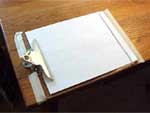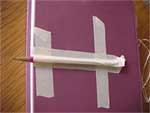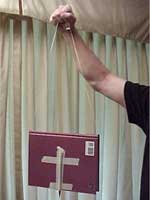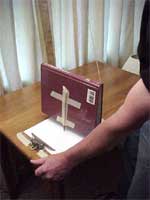Experiment - Personal Seismographs
 A seismograph records the intensity and duration of an earthquake. Even though you may not experience an actual earthquake, the following activities will give you an idea of how a seismograph works. Personal Seismograph #1 uses a book, string, pencil, tape, and paper, plus the help of a friend. It can be done in your home or classroom. Personal Seismograph #2 uses similar materials, but it will take you out in a car or bus to explore a bumpy road.
A seismograph records the intensity and duration of an earthquake. Even though you may not experience an actual earthquake, the following activities will give you an idea of how a seismograph works. Personal Seismograph #1 uses a book, string, pencil, tape, and paper, plus the help of a friend. It can be done in your home or classroom. Personal Seismograph #2 uses similar materials, but it will take you out in a car or bus to explore a bumpy road.
 |
 |
 |
Personal Seismograph #1
Here is what you will need:
- relatively large book, such as an earth science text book
- a piece of strong string about 2 m long
- sharpened pencil
- tape (masking tape if possible)
- several sheets of paper
- clipboard, optional
- large rubber band, optional
- small table or desk that can be moved
- a helper
Here is what you will do:
- Put the paper on a clipboard and tape the clipboard to the top of a desk or table. If you don’t have a clipboard, tape the paper directly to the desk or table.
- Tape a pencil to the cover of the book so that the point of the pencil extends beyond the side opposite the binding.
- Run a loop of string through the middle of the pages and tie the ends together. You can now hold the string and suspend the book so that it hangs over the paper on the table.
- You may wish to tape the book shut or secure it with a rubber band to keep it from flopping open.
- Position the book so that the pencil touches the top edge of the paper.
- Using a steady motion, pull the book/pencil down the length of the paper so that it draws a line. This is your control line. If necessary, draw several control lines until you are comfortable with the motion needed to draw a steady, continuous line.
- Now you are ready for a simulated earthquake. Draw a line from the top to the bottom of the paper as you did before, but this time ask a helper to shake the table perpendicular to the direction that the pencil is traveling.
- Repeat, using stronger and weaker shaking motions. Compare the results.
- Repeat, this time shaking the table in the direction that the pencil is traveling.
What do your lines look like? Compare them to our results.
This content has been re-published with permission from SEED. Copyright © 2025 Schlumberger Excellence in Education Development (SEED), Inc.
Course:
19764

